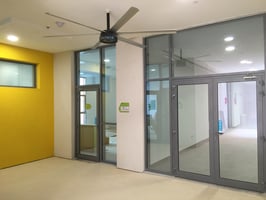5 Common Questions About HVLS Fans
Although HVLS fans have been on the market for a while, there are still people that are unfamiliar with them. Many of these people could be enjoying the benefits of HVLS fans if they understood a bit more about how these fans work and why they are so effective at helping with climate control concerns. Here are answers to five of the most common questions about HVLS fans:
1. How Much Does an HVLS Fan Cost?
The short answer: it depends. As is the case with most types of industrial equipment, there are many different manufacturers that create many different types of fans. A few things that impact the cost of an HVLS fan:
- Size
- Number of airfoils
- Manufacturer warranty
-
Remote control functionality
Broadly speaking, you can expect to pay anywhere from around $2,000 to over $7,000 for a top-quality, reliable HVLS fan.
Learn more about the cost of an HVLS Fan in this blog post:
2. How Does An HVLS Fan Compare To a Traditional One?
HVLS stands for high-volume, low-speed. The name for these fans reflects the main reasons they are different from traditional fans: they run at a slower speed than normal fans, delivering non-disruptive airflow, and they deliver a lot more airflow. The other big factor that separates HVLS fans from normal fans is the size of their blades (or airfoils). HVLS fans have longer blades so that they can generate larger columns of air that travel farther. This enables HVLS fans to thoroughly circulate the air in industrial applications that have large open areas like warehouses, hangars, etc.
3. What Are Some of the Most Common HVLS Fan Applications?
An HVLS fan can be placed anywhere there is a need for massive amounts of airflow. Some of the places we typically see HVLS fans used include:
- Warehouses
- Distribution centers
- Processing facilities
- Hangars
- Large restaurants and bars
- Public transit lobbies
This is a select list – there are many other places you can put HVLS fans, depending on the specific fan you buy and the needs of the facility.
4. How Long Will an HVLS Fan Last?
Like any piece of industrial equipment, there are a number of factors that go into determining how long an HVLS fan can be used. Some manufacturers use lower-quality parts so that they can charge a cheaper price upfront – these fans probably won't last as long as a more expensive, higher-quality fan.
To get an idea of how long a fan is expected to last, check out its warranty. The best HVLS fan warranties will cover your fan for years, or even decades, giving you confidence in the longevity of the fan.
5. How Does an HVLS Fan Interact With My Existing Building Systems?
This is an important question for facility managers and owners who are considering an HVLS fan for an existing space. The best HVLS fans are designed to integrate with your existing BMS, meaning you don't need to invest in a separate control system or expensive panel.
Conclusion
Learning the answers to common questions about HVLS fans is a great way to begin your research. But as you move through your buyer's journey, you will need to get the answers to specific questions about how an HVLS fan will work for your unique needs. Be sure to balance general research with your particular requirements so that you can get a better sense of which HVLS fan is best for you.

